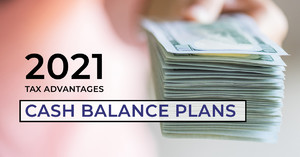Posted on Nov 16, 2021
A cash balance plan is an employer-sponsored defined benefit plan that can be created by any business entity including Corporations, LLCs, Partnerships, and Sole Proprietorships. They are an efficient way for business owners and key executives to build large retirement assets and gain certain tax advantages.
Once the plan is created, an employer credits a participant’s hypothetical account with a set dollar amount or a percentage of yearly compensation plus interest. Unlike a 401(k), the final vested benefits received by the participant upon retirement or termination are guaranteed and are not dependent on market fluctuations. Rather, the cash balance plan defines the benefit in terms of a hypothetical account balance, which the employee who is vested can take as a lump sum, annuity, or roll into another qualified plan, such as an IRA. The employer, not the participant, bears the risk of profits and losses in the portfolio.
Funds contributed to the plan are tax deductible the first year the plan is implemented and can result in significant tax deductions. In addition, the SECURE Act of 2020 allows businesses to retroactively adopt a new qualified plan, including cash balance plan, after the close of the plan year. This means that employers have until the due date of their business’s tax return, including extensions, to set up their cash balance plan and enjoy the tax advantages.
For this reason, a cash balance plan may be ideal for businesses demonstrating consistent cash flow and profits e.g., high-income professional practices and family businesses, sole proprietorships or partnerships, owners who want to maximize their retirement contributions, and companies that already make a profit-sharing contribution to their employees.
Besides the ability to build large retirement accounts quickly, cash balance plans also offer the following advantages:
- Cash balance plans offer generous contribution limits that increase with age. Compared to the much smaller limit in 401(k) plans, a maximum cash balance contribution in 2021 can exceed $300,000 depending on the individual’s age and income.
- The plans offer an easy-to-understand hypothetical account balance.
- The employer can opt to vary contributions by employee, and plan liability is easily defined.
- Assets can grow quickly and can provide large benefits for select employees.
- The employer has the option to offer a cash balance plan in addition to a 401(k) plan.
- Cash balance plans provide the portability and flexibility of a 401(k) plan, but allow for higher contribution limits.
For the participant, the addition of a cash balance plan can boost retirement savings. Taxation on benefits is deferred until the funds are received as income, just as in a 401(K) plan.
Like all qualified retirement plans, assets are protected from creditors. The investments of cash balance plans are managed by the employer, or an investment manager appointed by the employer. The benefits in some cash balance plans are protected (within certain limitations) by federal insurance provided through the Pension Benefit Guaranty Corporation (PBGC).[1]
This material is provided for informational purposes only, and is not intended as authoritative guidance, legal advice, or assurance of compliance with state and federal regulations.

